With Capturing the Moment open at Tate Modern, we look closer at artists who used the brush and the lens to transform art as we know it.
When Painting Met Photography Discover 5 artists who blurred the boundaries between painting and photography
The arrival of photography changed the course of painting forever
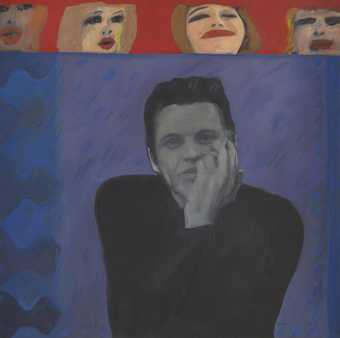
Pauline Boty
Portrait of Derek Marlowe with Unknown Ladies
(1962–3)
Tate
Pauline Boty: Painting and photography collide in pop art
The pop art movement exploded in the 1960s and many painters like Pauline Boty, Andy Warhol and Richard Hamilton started to explore this exciting new form of art. Inspired by popular culture, they looked at everything from Hollywood movies to advertising, paparazzi photos and television, to create images bursting with colour and energy. Boty used pop art to explore gender roles. In Portrait of Derek Marlowe with Unknown Ladies (1962–3), Marlowe, an English writer and painter, is relaxed and at ease in a pose typical in celebrity photographs at the time. The cut-off faces of the women are inspired by Marilyn Monroe – one of the most photographed women in the world.
Jeff Wall: Constructing photos like paintings
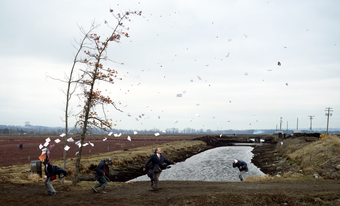
Jeff Wall A Sudden Gust of Wind (after Hokusai) 1993 Tate Purchased with assistance from the Patrons of New Art through the Tate Gallery Foundation and from the Art Fund 1995 © Jeff Wall
Jeff Wall is celebrated for his signature large-scale photographs on lightboxes. Trained in art history, he is a member of a group of artists known as the Vancouver School. A Sudden Gust of Wind (After Hokusai) (1993) is a vivid snapshot of ordinary life with four animated figures frozen, caught suddenly in a sweeping gust of wind. However, the photo is carefully staged. Wall took photos of actors on windy days and collaged and digitally superimposed parts of the image together, like the carefully placed sheets of paper blowing through the air.
‘Part of the poetry of traditional painting is the way it created an illusion that the painting depicted a single moment. In photography, there is always an actual moment – the moment the shutter is released' – Jeff Wall
Lorna Simpson: The digital age of painting
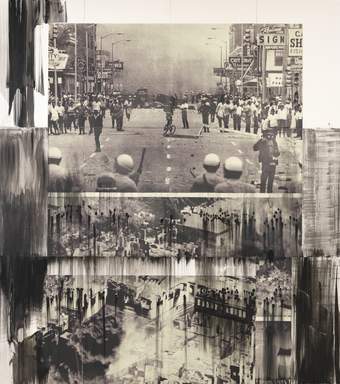
Many artists look at media from the past to create timely artwork that reflects the world today. Lorna Simpson uses multimedia to highlight issues from racism to international conflicts in the news. In Then and Now (2016), Simpson takes a photo from the Detroit riots in 1967 to create a screen-printed panel of images of police and protesters. In her artwork, the protesters notably appear powerless, covered in burnt-out foreboding dark shadows. Simpson made this piece when similar acts of rebellion were happening in the US – mirroring the riots that took place 50 years before.
Gerhard Richter: Capturing time on canvas
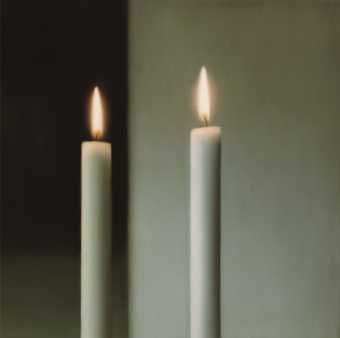
Gerhard Richter, Two Candles, 1982. Yageo Foundation Collection © Gerhard Richter 2022 (0153)
Photorealism started in the late 1960s. This is when artists tried to make their paintings as detailed and realistic as photographs. Artists like Gerhard Richter were inspired by history, media and memory and skilfully created paintings that look just like vivid copies of photographs. In rich photopaintings like Two Candles (1982), Richter uses painting to capture a fleeting moment of time on canvas forever – before the candles burn out.
Hiroshi Sugimoto: Photography as painting
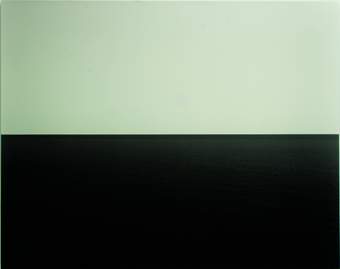
Hiroshi Sugimoto Tyrrhenian Sea, Conca 1994 YAGEO Foundation Collection, Taiwan © Hiroshi Sugimoto
Hiroshi Sugimoto is a photographer with a painter's eye. His works are ‘time-capsules’ of pictures on film. For Seascapes (1993) he uses a ‘time exposed’ technique to showcase the still beauty of the sea. This series features 220 black-and-white photographs taken over 30 years in different places all around the world. The works are captivating; strong and fragile with vast bold ocean views set against delicate cloudless skies. ‘Every time I view the sea, I feel a calming sense of security, as if visiting my ancestral home; I embark on a voyage of seeing.’
Capturing The Moment is on at Tate Modern until 28 April 2024.
